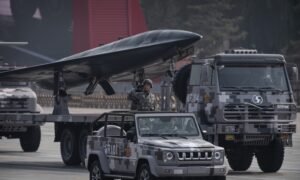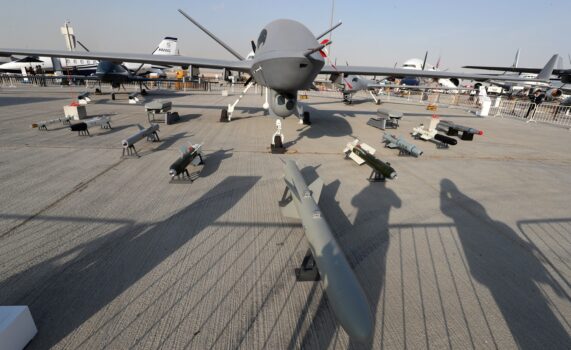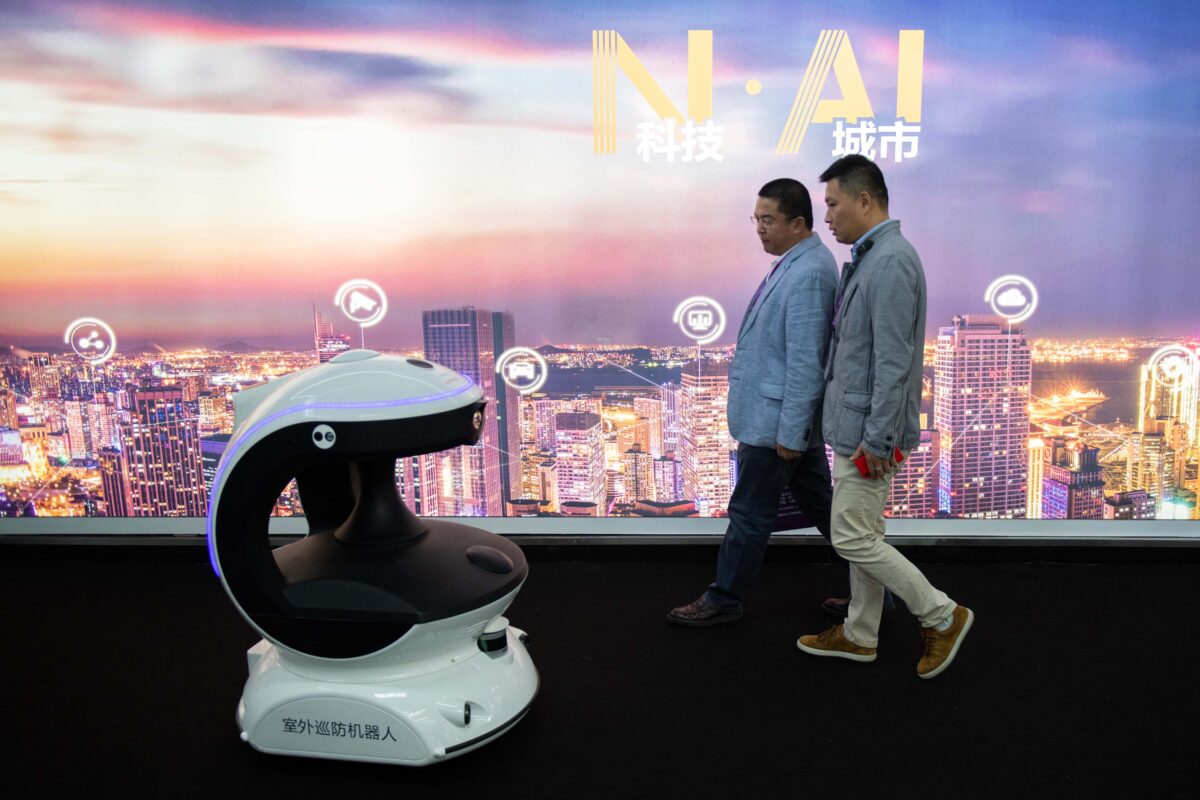IN-DEPTH: China Wants Killer Robots to Fight the Next War
War grips the world and the most powerful nations on earth go to battle once more. This time, however, it is machines that do the killing, operating free from all human oversight and accountability. It’s a grim picture of future conflicts, but one that the Chinese Communist Party (CCP) is nevertheless working to make a reality. The CCP is investing in artificial intelligence (AI)-enabled platforms that it hopes will one day conduct lethal missions in wartime, wholly without human input or control. Gregory Allen, director of the Wadhwani Center for AI and Advanced Technologies at the Center for Strategic and International Studies, says the regime is moving well beyond any attempt to keep a human in the AI decision-making loop. “China is pursuing development of AI-enabled lethal autonomous weapons,” Allen wrote in a prepared testimony for an April 13 hearing of the U.S.-China Economic and Security Review Commission. “The best available indications … suggest that China’s strategy is ambitious, moving beyond any sort of on-the-battlefield human supervision into increasingly autonomous AI-enabled warfare.” Though the CCP is investing heavily in a broad array of new technologies, Allen says, AI is foremost among them. The regime’s capacity to build AI-driven machines of war is quickly reaching parity with that of the United States, and may even exceed it soon. “U.S. leadership in the realm of military AI is not at all guaranteed,” Allen says. “While the United States has important advantages, China may be able to quickly take the lead in government and military adoption of AI capabilities. This is an outcome that the United States should seek to prevent.” A picture taken on Nov. 14, 2017, shows a Chinese-made Wing Loong II drone on display during the Dubai Airshow. (Karim Sahib/AFP via Getty Images) Autonomous AI Platforms ‘Inevitable’ The CCP’s pursuit of AI-driven weapons and other military platforms, though not well understood by many Americans, has been ongoing for years. Allen notes that he first realized the remarkable ambition of such goals back in 2018. At that time, he attended a conference where he transcribed a speech made by Zeng Yi, a senior executive at China’s state-owned military company Norinco. There, Zeng described Norinco’s ambitions—and the CCP’s expectations—for future implementation of AI weapons by saying that, “In future battlegrounds, there will be no people fighting.” “Zeng predicted that by 2025, lethal autonomous weapons would be commonplace,” Allen said, adding that Zeng had described the mass adoption of autonomous AI platforms as “inevitable.” Allen also noted that CCP censors removed Zeng’s comments and even his participation from the official readout of the conference shortly thereafter. “It was not in China’s interest to have that information in the open,” Allen said. Not long after that, however, the CCP-affiliated military company Ziyan began exporting its Blowfish A2 and A3 drones to the Middle East. The Blowfish, a helicopter-style drone capable of autonomously engaging with targets, using machine guns and missiles, was just the first realization of the regime’s ambition to transform war from a human domain into a robotic one. Military Decision-Making Without Humanity The regime’s ambitions for AI go beyond killer robots. The CCP is also investing to develop AI capabilities related to military decision-making and command and control. At the heart of the effort is the CCP’s goal of “intelligentization,” a transformation of warfare through the mass integration of AI, automation, and big data. Zeng posited that “intelligence supremacy will be the core of future warfare” and that “AI may completely change the current command structure, which is dominated by humans” to one that is dominated by an “AI cluster” that operates “just like the brain of the human body.” Building on that vision are Chinese companies like 4Paradigm, which was contracted by the CCP’s military wing to develop AI decision-making models and human-machine teaming software for use at the company and battalion levels. Such programs essentially aim toward one end: the restructuring of the Chinese military into an increasingly centralized cadre of officers who direct swarms of AI-enabled autonomous systems to do the actual fighting. Sam Kessler, an analyst for the North Star Support Group risk advisory firm, believes that the regime’s focus on shifting the burden of warfighting from humans to AI-enabled systems is indicative of a broader recognition among CCP leadership about the revolutionary nature of intelligent autonomous systems. “The [Chinese military] places a great deal of emphasis on disruptive technologies like autonomous systems,” Kessler said in an email to The Epoch Times. “Unmanned combat systems with digitized decision-making programs can potentially speed up the process of performing tasks on the battlefield,” Kessler added. “[These include] precision strikes, accurate re

War grips the world and the most powerful nations on earth go to battle once more. This time, however, it is machines that do the killing, operating free from all human oversight and accountability.
It’s a grim picture of future conflicts, but one that the Chinese Communist Party (CCP) is nevertheless working to make a reality.
The CCP is investing in artificial intelligence (AI)-enabled platforms that it hopes will one day conduct lethal missions in wartime, wholly without human input or control.
Gregory Allen, director of the Wadhwani Center for AI and Advanced Technologies at the Center for Strategic and International Studies, says the regime is moving well beyond any attempt to keep a human in the AI decision-making loop.
“China is pursuing development of AI-enabled lethal autonomous weapons,” Allen wrote in a prepared testimony for an April 13 hearing of the U.S.-China Economic and Security Review Commission.
“The best available indications … suggest that China’s strategy is ambitious, moving beyond any sort of on-the-battlefield human supervision into increasingly autonomous AI-enabled warfare.”
Though the CCP is investing heavily in a broad array of new technologies, Allen says, AI is foremost among them. The regime’s capacity to build AI-driven machines of war is quickly reaching parity with that of the United States, and may even exceed it soon.
“U.S. leadership in the realm of military AI is not at all guaranteed,” Allen says.
“While the United States has important advantages, China may be able to quickly take the lead in government and military adoption of AI capabilities. This is an outcome that the United States should seek to prevent.”
 A picture taken on Nov. 14, 2017, shows a Chinese-made Wing Loong II drone on display during the Dubai Airshow. (Karim Sahib/AFP via Getty Images)
A picture taken on Nov. 14, 2017, shows a Chinese-made Wing Loong II drone on display during the Dubai Airshow. (Karim Sahib/AFP via Getty Images)
Autonomous AI Platforms ‘Inevitable’
The CCP’s pursuit of AI-driven weapons and other military platforms, though not well understood by many Americans, has been ongoing for years.
Allen notes that he first realized the remarkable ambition of such goals back in 2018. At that time, he attended a conference where he transcribed a speech made by Zeng Yi, a senior executive at China’s state-owned military company Norinco.
There, Zeng described Norinco’s ambitions—and the CCP’s expectations—for future implementation of AI weapons by saying that, “In future battlegrounds, there will be no people fighting.”
“Zeng predicted that by 2025, lethal autonomous weapons would be commonplace,” Allen said, adding that Zeng had described the mass adoption of autonomous AI platforms as “inevitable.”
Allen also noted that CCP censors removed Zeng’s comments and even his participation from the official readout of the conference shortly thereafter.
“It was not in China’s interest to have that information in the open,” Allen said.
Not long after that, however, the CCP-affiliated military company Ziyan began exporting its Blowfish A2 and A3 drones to the Middle East. The Blowfish, a helicopter-style drone capable of autonomously engaging with targets, using machine guns and missiles, was just the first realization of the regime’s ambition to transform war from a human domain into a robotic one.
Military Decision-Making Without Humanity
The regime’s ambitions for AI go beyond killer robots. The CCP is also investing to develop AI capabilities related to military decision-making and command and control.
At the heart of the effort is the CCP’s goal of “intelligentization,” a transformation of warfare through the mass integration of AI, automation, and big data.
Zeng posited that “intelligence supremacy will be the core of future warfare” and that “AI may completely change the current command structure, which is dominated by humans” to one that is dominated by an “AI cluster” that operates “just like the brain of the human body.”
Building on that vision are Chinese companies like 4Paradigm, which was contracted by the CCP’s military wing to develop AI decision-making models and human-machine teaming software for use at the company and battalion levels.
Such programs essentially aim toward one end: the restructuring of the Chinese military into an increasingly centralized cadre of officers who direct swarms of AI-enabled autonomous systems to do the actual fighting.
Sam Kessler, an analyst for the North Star Support Group risk advisory firm, believes that the regime’s focus on shifting the burden of warfighting from humans to AI-enabled systems is indicative of a broader recognition among CCP leadership about the revolutionary nature of intelligent autonomous systems.
“The [Chinese military] places a great deal of emphasis on disruptive technologies like autonomous systems,” Kessler said in an email to The Epoch Times.
“Unmanned combat systems with digitized decision-making programs can potentially speed up the process of performing tasks on the battlefield,” Kessler added. “[These include] precision strikes, accurate reconnaissance, resupplying forces, and performing field modifications more precisely and effectively.”
Such capabilities, Kessler said, could provide even a meager military with a profound force multiplier, and could shift the balance of power in future conflicts.
“Whoever possesses this kind of technology can help make even the weakest or average conventional military power have an edge in a field of battle, or prolonging it,” Kessler said.
 Visitors walk past an AI (artificial intelligence) security robot named APV3 with a facial recognition system at the 14th China International Exhibition on Public Safety and Security at the China International Exhibition Center in Beijing on Oct. 24, 2018. (Nicolas Asfouri/AFP via Getty Images)
Visitors walk past an AI (artificial intelligence) security robot named APV3 with a facial recognition system at the 14th China International Exhibition on Public Safety and Security at the China International Exhibition Center in Beijing on Oct. 24, 2018. (Nicolas Asfouri/AFP via Getty Images)
Future of War Is Robotic
The CCP is not alone in its ambition to lead a new revolution in military affairs. Many U.S. military leaders believe the dawn of AI-enabled lethal autonomous systems is near.
Chairman of the Joint Chiefs of Staff Gen. Mark Milley shares a similar vision to that of China’s Zeng. He believes that the world’s most powerful militaries will be primarily robotic in 10-15 years.
“Over the next 10 to 15 years, you’ll see large portions of advanced countries’ militaries become robotic,” Milley said. “If you add robotics with artificial intelligence and precision munitions and the ability to see at range, you’ve got the mix of a real fundamental change.
“That’s coming. Those changes, that technology … we are looking at inside of 10 years.”
Lt. Gen. Ross Coffman, head of the Army Futures Command, believes that the United States will enter an age characterized by artificially intelligent killing machines by 2040.
Coffman described the partnership between soldiers and AI as that between a dog and its master during a March 28 summit of Department of Defense leaders and technology experts.
In a future war, however, it will be soldiers helping AI get into the fight rather than the other way around.
“I think we’re going to see a flip in 2040 where humans are doing those functions that allow the machine to get into a position of relative advantage, not the machine getting humans into a position of relative advantage,” Coffman said.
That aim is likely to face a bumpy path forward as the United States contends with China’s embrace of lethal AI systems, according to Kessler.
“The DoD recently announced they intend to continue developing AI and autonomous lethal systems … that will enable them to keep an edge in the changing global security environment,” Kessler said. “However, keeping a human element involved in the operation of AI autonomous and semi-autonomous lethal systems also remains a priority.
“Since the [Chinese military] is not committed to this DoD strategy and belief system, it will force the U.S. to invest heavily into it. It will also require the U.S. to ensure that the balance between being ethical and conducting oversight does not get in the way of being lethal and operational at the same time.”
 An AI cancer detection microscope by Google is seen during the World Artificial Intelligence Conference 2018 (WAIC 2018) in Shanghai on Sept. 18, 2018. (STR/AFP/Getty Images)
An AI cancer detection microscope by Google is seen during the World Artificial Intelligence Conference 2018 (WAIC 2018) in Shanghai on Sept. 18, 2018. (STR/AFP/Getty Images)
Chinese Robots, American Research
As the CCP continues its quest for intelligentized warfare, Allen believes that a critical weakness the United States must overcome is its indirect support of China’s AI industry.
Because the United States considers AI to be a discrete technology rather than a category of general-purpose technology like electricity or computers, the CCP is able to inadvertently develop its military capabilities through otherwise mundane research and development partnerships with the U.S.
“The linkages between China’s AI sector and the United States’ AI sector are extraordinarily deep,” Allen said. “There really isn’t a part of the Chinese AI ecosystem that isn’t in some way drawing upon the U.S. AI ecosystem.”
Allen noted that half of all Chinese academic papers published on the subject of AI feature American co-authors.
Some of those research endeavors even include collaborations between major U.S. corporations and the companies responsible for pioneering China’s military AI development.
In one example, Intel conducted research with 4Paradigm, even at the same time the company was contracted to develop AI decision-making models for the Chinese military. Google, meanwhile, has collaborated extensively with military-linked entities in China through its China-based AI centers.
That research and any subsequent technological development based on it in China is then able to be effectively co-opted by the CCP through its strategy of Military-Civil Fusion (MCF), which mandates that all research and technologies serve national security needs in addition to civil needs.
The sheer volume of AI research and development being compiled by the regime through MCF is allowing the CCP to effectively catch up with the United States technologically, according to Elsa Kania, an adjunct senior fellow at the Center for a New American Security think tank.
“We have to recognize [MCF] as an incredibly consequential component of China’s goal to catch up with or supersede the United States,” Kania said. “At a certain point, the quantity and the amount of resources put into these efforts do start to produce quality.”
Kania added that a key goal of MCF was to realize the regime’s desire to become a “pioneer at the forefront of technologies defining a new revolution in military affairs,” and to “access and exploit dual use technologies,” including artificial intelligence and robotics.
“The writing has been on the wall for a while,” Kania said. “Intelligentization is what the PLA regards as the future of warfare.”
As such, Kania warned that, without adequate oversight measures, the regime’s development of AI-enabled weapons would continue at the expense of American national security.
“There’s a risk that any investment in China [without oversight] … has a risk of inadvertently contributing to military modernization,” Kania said. “There is a need for increased oversight and screening for outbound investments in those technologies … [to ensure that] U.S. flows of funding are not inadvertently undermining U.S. interests.”












